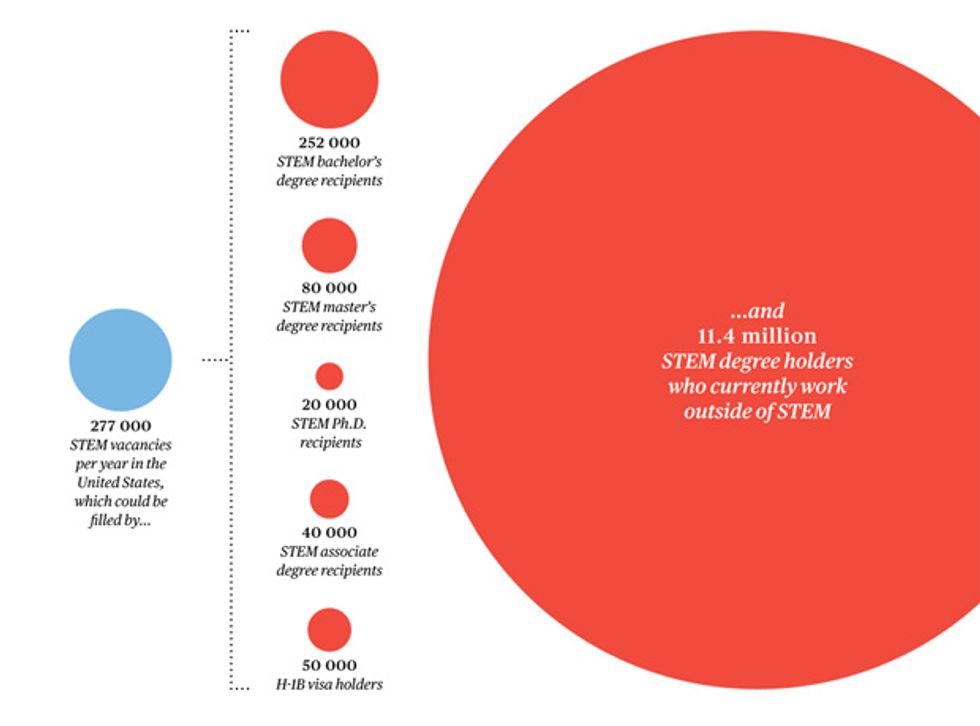The STEM Crisis Is a Myth
Forget the dire predictions of a looming shortfall of scientists, technologists, engineers, and mathematicians

You must have seen the warning a thousand times: Too few young people study scientific or technical subjects, businesses can't find enough workers in those fields, and the country's competitive edge is threatened.
It pretty much doesn't matter what country you're talking about—the United States is facing this crisis, as is Japan, the United Kingdom, Australia, China, Brazil, South Africa, Singapore, India…the list goes on. In many of these countries, the predicted shortfall of STEM (short for science, technology, engineering, and mathematics) workers is supposed to number in the hundreds of thousands or even the millions. A 2012 report by President Obama's Council of Advisors on Science and Technology, for instance, stated that over the next decade, 1 million additional STEM graduates will be needed. In the U.K., the Royal Academy of Engineering reported last year that the nation will have to graduate 100 000 STEM majors every year until 2020 just to stay even with demand. Germany, meanwhile, is sa to have a shortage of about 210 000 workers in what's known there as the MINT disciplines—mathematics, computer science, natural sciences, and technology.
The situation is so dismal that governments everywhere are now pouring billions of dollars each year into myriad efforts designed to boost the ranks of STEM workers. President Obama has called for government and industry to train 10 000 new U.S. engineers every year as well as 100 000 additional STEM teachers by 2020. And until those new recruits enter the workforce, tech companies like Facebook, IBM, and Microsoft are lobbying to boost the number of H-1B visas—temporary immigration permits for skilled workers—from 65 000 per year to as many as 180 000. The European Union is similarly introducing the new Blue Card visa to bring in skilled workers from outside the EU. The government of India has said it needs to add 800 new universities, in part to avoid a shortfall of 1.6 million university-educated engineers by the end of the decade.
And yet, alongside such dire projections, you'll also find reports suggesting just the opposite—that there are more STEM workers than suitable jobs. One study found, for example, that wages for U.S. workers in computer and math fields have largely stagnated since 2000. Even as the Great Recession slowly recedes, STEM workers at every stage of the career pipeline, from freshly minted grads to mid- and late-career Ph.D.s, still struggle to find employment as many companies, including Boeing, IBM, and Symantec, continue to lay off thousands of STEM workers.

To parse the simultaneous claims of both a shortage and a surplus of STEM workers, we'll need to delve into the data behind the debate, how it got going more than a half century ago, and the societal, economic, and nationalistic biases that have perpetuated it. And what that dissection reveals is that there is indeed a STEM crisis—just not the one everyone's been talking about. The real STEM crisis is one of literacy: the fact that today's students are not receiving a solid grounding in science, math, and engineering.
In preparing this article, I went through hundreds of reports, articles, and white papers from the past six decades. There were plenty of data, but there was also an extraordinary amount of inconsistency. Who exactly is a STEM worker: somebody with a bachelor's degree or higher in a STEM discipline? Somebody whose job requires use of a STEM subject? What about someone who manages STEM workers? And which disciplines and industries fall under the STEM umbrella?
Such definitions obviously affect the counts. For example, in the United States, both the National Science Foundation (NSF) and the Department of Commerce track the number of STEM jobs, but using different metrics. According to Commerce, 7.6 million individuals worked in STEM jobs in 2010, or about 5.5 percent of the U.S. workforce. That number includes professional and technical support occupations in the fields of computer science and mathematics, engineering, and life and physical sciences as well as management. The NSF, by contrast, counts 12.4 million science and engineering jobs in the United States, including a number of areas that the Commerce Department excludes, such as health-care workers (4.3 million) and psychologists and social scientists (518 000).
Such inconsistencies don't just create confusion for numbers junkies like me; they also make rational policy discussions difficult. Depending on your point of view, you can easily cherry-pick data to bolster your argument.
Another surprise was the apparent mismatch between earning a STEM degree and having a STEM job. Of the 7.6 million STEM workers counted by the Commerce Department, only 3.3 million possess STEM degrees. Viewed another way, about 15 million U.S. residents hold at least a bachelor's degree in a STEM discipline, but three-fourths of them—11.4 million—work outside of STEM.
The departure of STEM graduates to other fields starts early. In 2008, the NSF surveyed STEM graduates who'd earned bachelor's and master's degrees in 2006 and 2007. It found that
2 out of 10 were already working in non-STEM fields. And 10 years after receiving a STEM degree, 58 percent of STEM graduates had left the field, according to a 2011 study from Georgetown University.
The STEM Crisis Through the Decades
Predictions of an impending shortage of scientists and engineers are nothing new
"Right now…there is a sufficiency of engineers, but one of our greatest industrial organizations, after careful study, predicts the entire absorption of this group by the end of 1936, with a probable shortage of available engineers at that time."
dean of New York University's College of Engineering, 1934
"With mounting demands for scientists both for teaching and for research, we will enter the postwar period with a serious deficit in our trained scientific personnel."
director of the U.S. Office of Scientific Research and Development, 1945
"Our national welfare, our defense, our standard of living could all be jeopardized by the mismanagement of this supply and demand problem in the field of trained creative intelligence."
president of MIT, 1954
"From 1972 through 1975, the expected demand for engineers will exceed not only the supply coming from American engineering schools, but also the combined supply from the United States and foreign countries, according to the [Engineering Manpower Commission] estimates."
president of Clarkson College of Technology, 1970
"The electronics and information technology industries will be short more than 100 000 electrical and computer science engineers over the next five years."
1983
"Already spot shortages exist in some science fields in the United States, and unless dramatic changes are made in the way we educate all of our students, including our most talented, the shortages will increase."
1993
"U.S. companies face a severe shortfall of scientists and engineers with expertise to develop the next generation of breakthroughs."
chairman of Microsoft, 2008
"There is a skills gap in this country—for every unemployed person in the United States, there are two STEM job postings. The gap will only widen if we don't engage now to address STEM education at the elementary and high school levels."
chairman, president, and CEO of Texas Instruments, 2013
The takeaway? At least in the United States, you don't need a STEM degree to get a STEM job, and if you do get a degree, you won't necessarily work in that field after you graduate. If there is in fact a STEM worker shortage, wouldn't you expect more people with STEM degrees to be filling those jobs? And if many STEM jobs can be filled by people who don't have STEM degrees, then why the big push to get more students to pursue STEM?
Now consider the projections that suggest a STEM worker shortfall. One of the most cited in recent U.S. debates comes from the 2011 Georgetown University report mentioned above, by Anthony P. Carnevale, Nicole Smith, and Michelle Melton of the Center on Education and the Workforce. It estimated there will be slightly more than 2.4 million STEM job openings in the United States between 2008 and 2018, with 1.1 million newly created jobs and the rest to replace workers who retire or move to non-STEM fields; they conclude that there will be roughly 277 000 STEM vacancies per year.
But the Georgetown study did not fully account for the Great Recession. It projected a downturn in 2009 but then a steady increase in jobs beginning in 2010 and a return to normal by the year 2018. In fact, though, more than 370 000 science and engineering jobs in the United States were lost in 2011, according to the Bureau of Labor Statistics.
I don't mean to single out this study for criticism; it just illustrates the difficulty of accurately predicting STEM demand and supply even a year or two out, let alone over a prolonged period. Highly competitive science- and technology-driven industries are volatile, where radical restructurings and boom-and-bust cycles have been the norm for decades. Many STEM jobs today are also targets for outsourcing or replacement by automation.
The nature of STEM work has also changed dramatically in the past several decades. In engineering, for instance, your job is no longer linked to a company but to a funded project. Long-term employment with a single company has been replaced by a series of de facto temporary positions that can quickly end when a project ends or the market shifts. To be sure, engineers in the 1950s were sometimes laid off during recessions, but they expected to be hired back when the economy picked up. That rarely happens today. And unlike in decades past, employers seldom offer generous education and training benefits to engineers to keep them current, so out-of-work engineers find they quickly become technologically obsolete.
Any of these factors can affect both short-term and longer-term demand for STEM workers, as well as for the particular skills those workers will need. The agencies that track science and engineering employment know this to be true. Buried in Chapter 3 of a 2012 NSF workforce study, for instance, you'll find this caveat: "Projections of employment growth are plagued by uncertain assumptions and are notoriously difficult to make."
So is there a shortfall of STEM workers or isn't there?
The Georgetown study estimates that nearly
two-thirds of the STEM job openings [PDF] in the United States, or about 180 000 jobs per year, will require bachelor's degrees. Now, if you apply the Commerce Department's definition of STEM to the NSF's annual count of science and engineering bachelor's degrees, that means about 252 000 STEM graduates emerged in 2009. So even if all the STEM openings were entry-level positions and even if only new STEM bachelor's holders could compete for them, that still leaves 70 000 graduates unable to get a job in their chosen field.
Of course, the pool of U.S. STEM workers is much bigger than that: It includes new STEM master's and Ph.D. graduates (in 2009, around 80 000 and 25 000, respectively), STEM associate degree graduates (about 40 000), H-1B visa holders (more than 50 000), other immigrants and visa holders with STEM degrees, technical certificate holders, and non-STEM degree recipients looking to find STEM-related work. And then there's the vast number of STEM degree holders who graduated in previous years or decades.
Even in the computer and IT industry, the sector that employs the most STEM workers and is expected to grow the most over the next 5 to 10 years, not everyone who wants a job can find one. A recent study by the Economic Policy Institute (EPI), a liberal-leaning think tank in Washington, D.C., found that more than a third of recent computer science graduates aren't working in their chosen major; of that group, almost a third say the reason is that there are no jobs available.
Spot shortages for certain STEM specialists do crop up. For instance, the recent explosion in data analytics has sparked demand for data scientists in health care and retail. But the H-1B visa and similar immigrant hiring programs are meant to address such shortages. The problem is that students who are contemplating what field to specialize in can't assume such shortages will still exist by the time they emerge from the educational pipeline.
What's perhaps most perplexing about the claim of a STEM worker shortage is that many studies have directly contradicted it, including reports from Duke University, the Rochester Institute of Technology, the Alfred P. Sloan Foundation, and the Rand Corp. A 2004 Rand study, for example, stated that there was no evidence "that such shortages have existed at least since 1990, nor that they are on the horizon."
That report argued that the best indicator of a shortfall would be a widespread rise in salaries throughout the STEM community. But the price of labor has not risen, as you would expect it to do if STEM workers were scarce. In computing and IT, wages have generally been stagnant for the past decade, according to the EPI and other analyses. And over the past 30 years, according to the Georgetown report, engineers' and engineering technicians' wages have grown the least of all STEM wages and also more slowly than those in non-STEM fields; while STEM workers as a group have seen wages rise 33 percent and non-STEM workers' wages rose by 23 percent, engineering salaries grew by just 18 percent. The situation is even more grim for those who get a Ph.D. in science, math, or engineering. The Georgetown study states it succinctly: "At the highest levels of educational attainment, STEM wages are not competitive."
Given all of the above, it is difficult to make a case that there has been, is, or will soon be a STEM labor shortage. "If there was really a STEM labor market crisis, you'd be seeing very different behaviors from companies," notes Ron Hira, an associate professor of public policy at the Rochester Institute of Technology, in New York state. "You wouldn't see companies cutting their retirement contributions, or hiring new workers and giving them worse benefits packages. Instead you would see signing bonuses, you'd see wage increases. You would see these companies really training their incumbent workers."
"None of those things are observable," Hira says. "In fact, they're operating in the opposite way."
So why the persistent anxiety that a STEM crisis exists? Michael S. Teitelbaum, a Wertheim Fellow at Harvard Law School and a senior advisor to the Alfred P. Sloan Foundation, has studied the phenomenon, and he says that in the United States the anxiety dates back to World War II. Ever since then it has tended to run in cycles that he calls "alarm, boom, and bust." He says the cycle usually starts when "someone or some group sounds the alarm that there is a critical crisis of insufficient numbers of scientists, engineers, and mathematicians" and as a result the country "is in jeopardy of either a national security risk or of falling behind economically." In the 1950s, he notes, Americans worried that the Soviet Union was producing 95 000 scientists and engineers a year while the United States was producing only about 57 000. In the 1980s, it was the perceived Japanese economic juggernaut that was the threat, and now it is China and India.
You'll hear similar arguments made elsewhere. In India, the director general of the Defence Research and Development Organisation, Vijay Kumar Saraswat, recently noted that in his country, "a meagre four persons out of every 1000 are choosing S&T or research, as compared to 110 in Japan, 76 in Germany and Israel, 55 in USA, 46 in Korea and 8 in China." Leaders in South Africa and Brazil cite similar statistics to show how they are likewise falling behind in the STEM race.
"The government responds either with money [for research] or, more recently, with visas to increase the number of STEM workers," Teitelbaum says. "This continues for a number of years until the claims of a shortage turn out not to be true and a bust ensues." Students who graduate during the bust, he says, are shocked to discover that "they can't find jobs, or they find jobs but not stable ones."
At the moment, we're in the alarm-heading-toward-boom part of the cycle. According to a recent report from the Government Accountability Office, the U.S. government spends more than US $3 billion each year on 209 STEM-related initiatives overseen by 13 federal agencies. That's about $100 for every U.S. student beyond primary school. In addition, major corporations are collectively spending millions to support STEM educational programs. And every U.S. state, along with a host of public and private universities, high schools, middle schools, and even primary schools, has its own STEM initiatives. The result is that many people's fortunes are now tied to the STEM crisis, real or manufactured.
Clearly, powerful forces must be at work to perpetuate the cycle. One is obvious: the bottom line. Companies would rather not pay STEM professionals high salaries with lavish benefits, offer them training on the job, or guarantee them decades of stable employment. So having an oversupply of workers, whether domestically educated or imported, is to their benefit. It gives employers a larger pool from which they can pick the "best and the brightest," and it helps keep wages in check. No less an authority than Alan Greenspan, former chairman of the Federal Reserve, said as much when in 2007 he advocated boosting the number of skilled immigrants entering the United States so as to "suppress" the wages of their U.S. counterparts, which he considered too high.
Governments also push the STEM myth because an abundance of scientists and engineers is widely viewed as an important engine for innovation and also for national defense. And the perception of a STEM crisis benefits higher education, says Ron Hira, because as "taxpayers subsidize more STEM education, that works in the interest of the universities" by allowing them to expand their enrollments.
An oversupply of STEM workers may also have a beneficial effect on the economy, says Georgetown's Nicole Smith, one of the coauthors of the 2011 STEM study. If STEM graduates can't find traditional STEM jobs, she says, "they will end up in other sectors of the economy and be productive."
The problem with proclaiming a STEM shortage when one doesn't exist is that such claims can actually create a shortage down the road, Teitelbaum says. When previous STEM cycles hit their "bust" phase, up-and-coming students took note and steered clear of those fields, as happened in computer science after the dot-com bubble burst in 2001.
Emphasizing STEM at the expense of other disciplines carries other risks. Without a good grounding in the arts, literature, and history, STEM students narrow their worldview—and their career options.
In a 2011 op-ed in The Wall Street Journal, Norman Augustine, former chairman and CEO of Lockheed Martin, argued that point. "In my position as CEO of a firm employing over 80 000 engineers, I can testify that most were excellent engineers," he wrote. "But the factor that most distinguished those who advanced in the organization was the ability to think broadly and read and write clearly."
A broader view, I and many others would argue, is that everyone needs a solid grounding in science, engineering, and math. In that sense, there is indeed a shortage—a STEM knowledge shortage. To fill that shortage, you don't necessarily need a college or university degree in a STEM discipline, but you do need to learn those subjects, and learn them well, from childhood until you head off to college or get a job. Improving everyone's STEM skills would clearly be good for the workforce and for people's employment prospects, for public policy debates, and for everyday tasks like balancing checkbooks and calculating risks. And, of course, when science, math, and engineering are taught well, they engage students' intellectual curiosity about the world and how it works.
Many children born today are likely to live to be 100 and to have not just one distinct career but two or three by the time they retire at 80. Rather than spending our scarce resources on ending a mythical STEM shortage, we should figure out how to make all children literate in the sciences, technology, and the arts to give them the best foundation to pursue a career and then transition to new ones. And instead of continuing our current global obsession with STEM shortages, industry and government should focus on creating more STEM jobs that are enduring and satisfying as well.
To Probe Further
Science and Engineering Careers in the United States: An Analysis of Markets and Employment (University of Chicago Press, 2009), edited by Richard B. Freeman and Daniel L. Goroff, provides a highly useful introduction to the forces in the early to mid-2000s that shaped current STEM shortage arguments in the United States.
Chapter 13 of Benoît Godin's Measurement and Statistics on Science and Technology: 1920 to the Present (Routledge Studies in the History of Science, Technology, and Medicine, 2012) shows how the claims of scientist and engineer shortages in the United States and United Kingdom after the Second World War were based on dubious statistics, and notes that the success rate of U.S. government predictions on the supply and demand for scientists and engineers has been about zero.
The National Research Council's Rising Above the Gathering Storm: Energizing and Employing America for a Brighter Economic Future (The National Academies Press, 2007) and Rising Above the Gathering Storm, Revisited: Rapidly Approaching Category 5 (The National Academies Press, 2010)are must reads. The first report triggered the current STEM shortage debate in the United States, and the second one fanned the flames. Written by a select committee of business and academic leaders, the first report concluded that the United States appeared to be "on a losing path" in its ability to innovate and globally compete, because the U.S. school system was failing to prepare the nation's future STEM workers. The second report concluded that because the first report's recommendations had not been funded, the situation was now reaching catastrophic proportions. If these reports were the only ones you read on the subject, you too would believe there is a national STEM crisis.
One of the key conclusions of Hal Salzman, Daniel Kuehn, and B. Lindsay Lowell's "Guestworkers in the High-Skill U.S. Labor Market" (Briefing Paper #359, Economic Policy Institute, 24 April 2013) is that while there is an adequate supply of U.S. STEM workers and potential STEM graduates, this may not be the case in the IT sector, given that guest workers are willing to work "at wages that are too low to induce a significantly increased supply from the domestic workforce."
In "The Hidden STEM Economy" (Brookings Institution, 2013), Jonathan Rothwell argues that STEM workers include not just those with bachelor's or higher degrees, but anyone who uses "specialized knowledge" in any STEM discipline, such as plumbers and auto mechanics. Counted this way, there are 26 million STEM jobs in the United States, or about 20 percent of the workforce, as opposed to the 5 million to 6 million jobs counted the traditional way. Many of Rothwell's arguments echoed those made in a 1964 report from the American Council on Education entitled "Man, Education, and Work: Post Secondary Vocational and Technical Education."
One oft-cited argument for boosting the number of U.S. STEM graduates is that China and India are each graduating hundreds of thousands of engineers per year. But in their 2007 article "Where the Engineers Are" (Issues in Science and Technology), Vivek Wadhwa of Duke University and his colleagues revealed that the graduation numbers from China and India have been exaggerated; for example, in China, they write, "a motor mechanic or a technician could be considered an engineer." The authors argued that the United States should still increase its investment in R&D and STEM education, as both India and China would no doubt work to improve the quality of their own STEM graduates.
Ron Hira, a professor at the Rochester Institute of Technology, wrote a series of reports as part of the STEM Workforce Data Project. In "U.S. Policy and the STEM Workforce System" (Commission on Professionals in Science and Technology, 2007), he analyzes why, given STEM's supposed importance to the nation's standard of living and national defense, there is so little objective information for making informed policy decisions.
"The Current Model of STEM Graduate Education and Postdocs" [PDF] is a presentation given in November 2007 by Michael S. Teitelbaum, senior advisor to the Alfred P. Sloan Foundation. A world-respected demographer, he looks at the claims of STEM shortages and shortfalls at the graduate level and calls them a "long, embarrassing history."
"Will the Scientific and Technology Workforce Meet the Requirements of the Federal Government?," a 2004 report by William Butz and colleagues at the Rand Corp., found no evidence, regardless of what measure was used, "that [STEM] shortages have existed at least since 1990, nor that they are on the horizon."
Does the U.S. Department of Defense face a STEM worker shortage? No, concludes "Assuring the U.S. Department of Defense a Strong Science, Technology, Engineering, and Mathematics (STEM) Workforce" (National Research Council, 2012), a report from the National Academies. What's more, the report finds, "DOD representatives state virtually unanimously that they foresee no shortage of STEM workers in the years ahead except in a few specialty fields." Those specialties include cybersecurity, as well as anthropology, linguistics, and sociology.
Heather B. Gonzalez and Jeffrey J. Kuenzi's "Science, Technology, Engineering, and Mathematics (STEM) Education: A Primer" [PDF] (Congressional Research Service, 1 August 2012) clearly and succinctly lays out the major issues involved in the STEM debate.
In 2013 the Australian Industry Group, a nonprofit group representing some 60 000 businesses in Australia, published "Lifting Our Science, Technology, Engineering and Maths (STEM) Skills." [PDF] It called for "a major re-think by Australian education at all levels and in all sectors" to increase both the number and quality of Australian STEM graduates. In its tone and recommendations, it's very similar to the U.S. "Gathering Storm" reports.
The U.K. equivalent to the "Gathering Storm" reports is "Jobs and Growth: the Importance of Engineering Skills to the Economy," [PDF] published in 2012 by the Royal Academy of Engineering. It concluded that the United Kingdom needs an annual minimum of 100 000 STEM graduates, along with another 60 000 technically trained individuals, over the next decade just to maintain the status quo. Unlike in the United States, where engineering salaries have stagnated, the report found "a persistent, sizeable wage premium for people holding engineering degrees" in the past 20 years.
The German equivalent to STEM is MINT—mathematics, computer science, natural sciences, and technology. Written in German, "MINT-Frühjahrsreport 2013" (MINT Spring Report 2013), published by the Cologne Institute for Economic Research, analyzes German employment data for MINT workers, from academics to technicians. One useful metric is the comparison of job openings with unemployed workers in different MINT categories and occupations, although there are limits to this approach.









